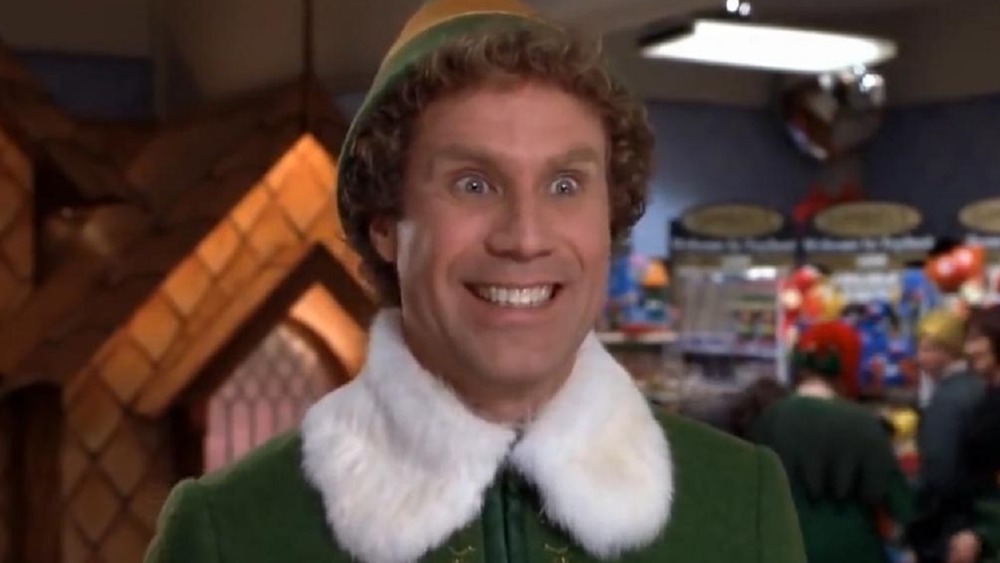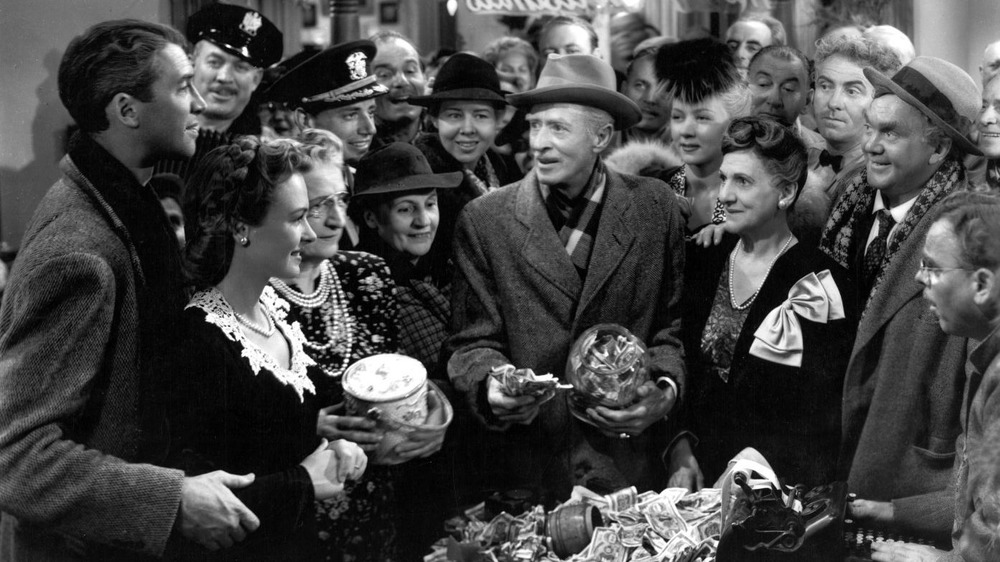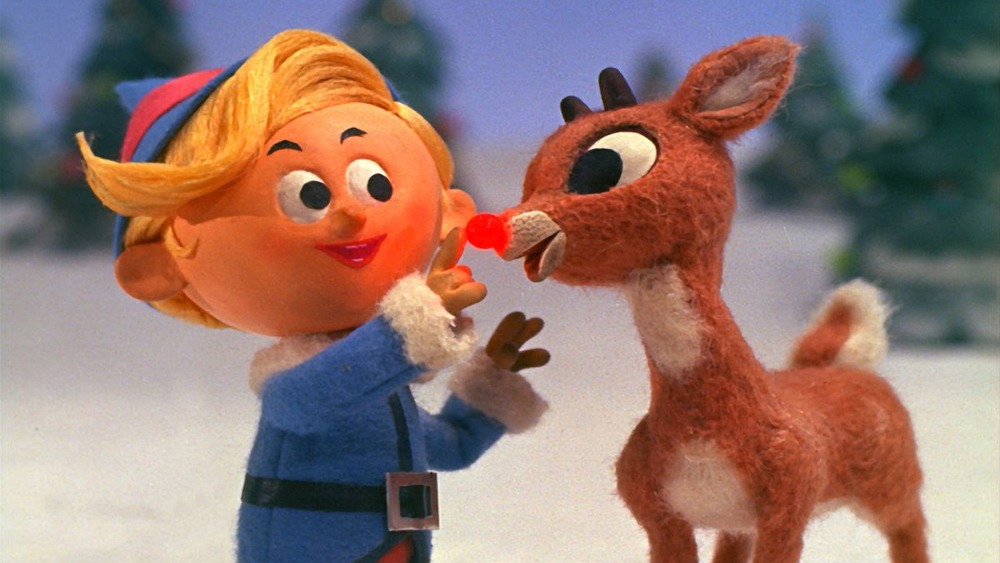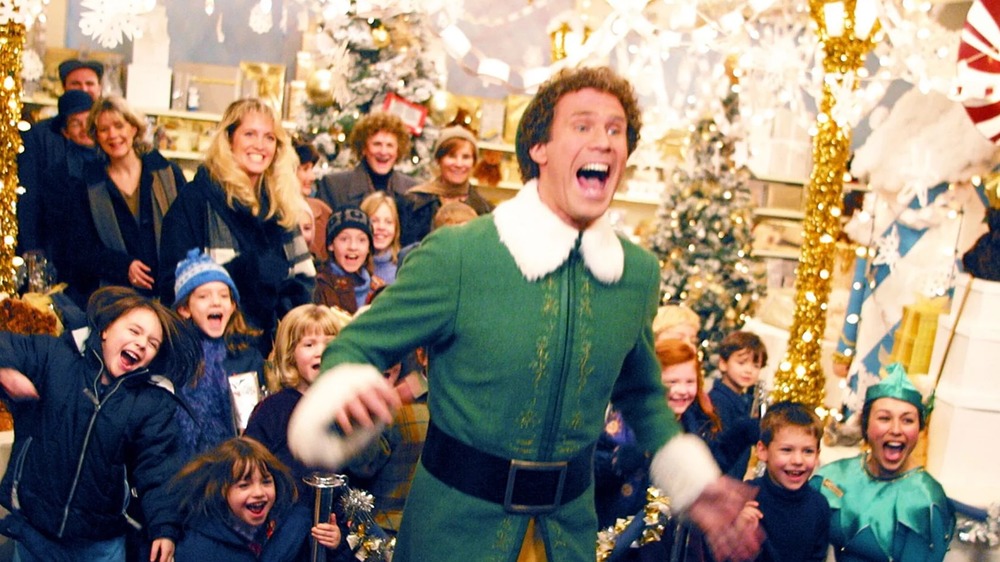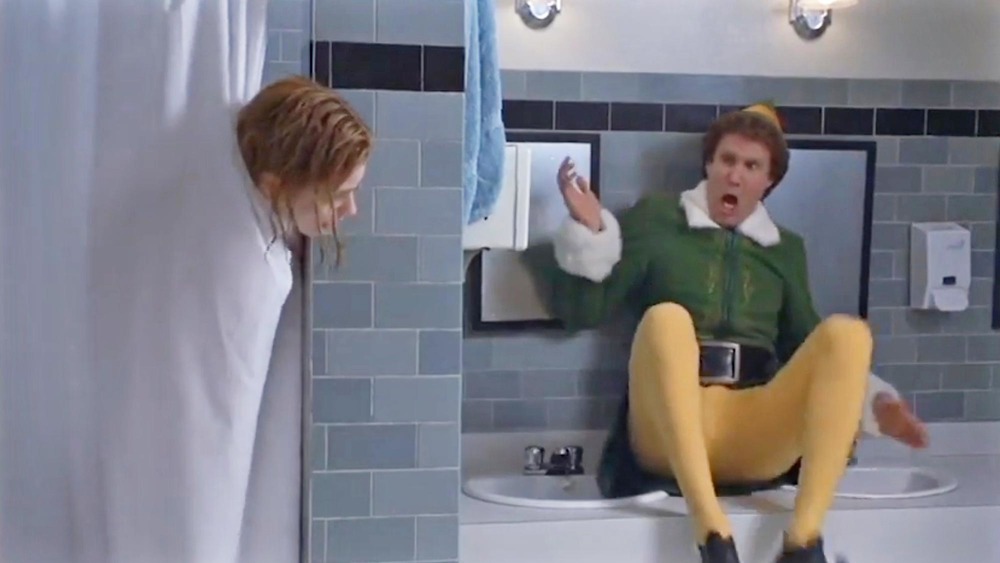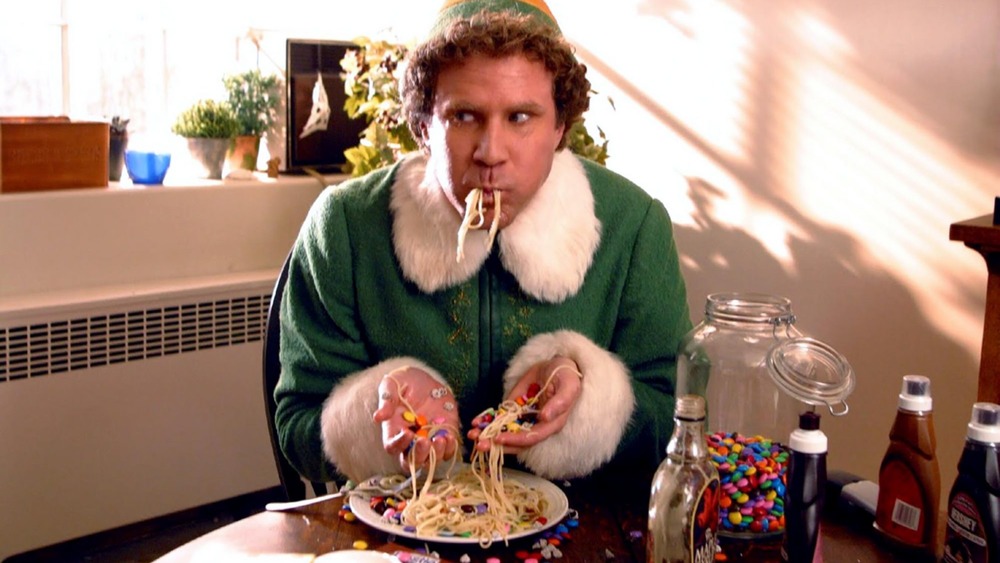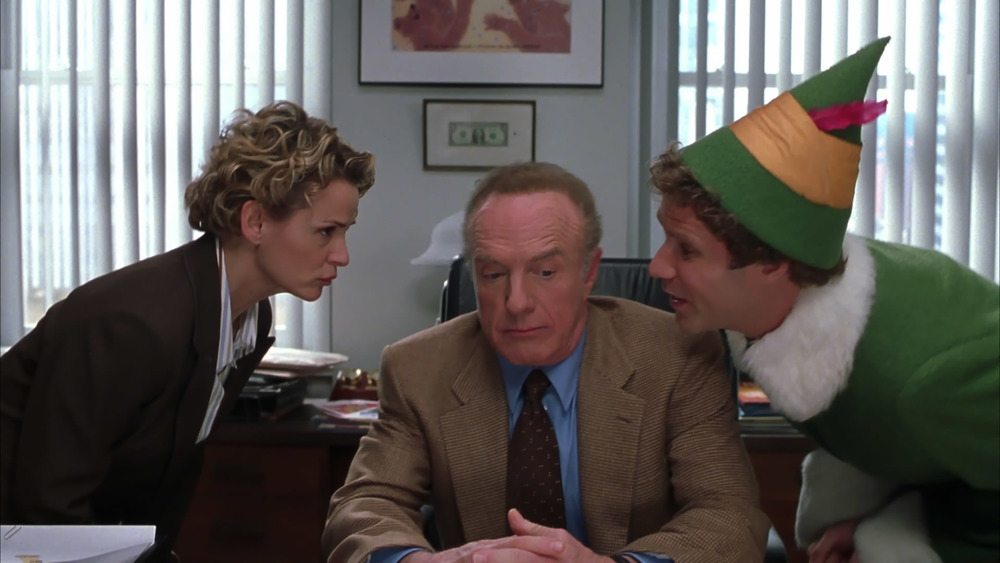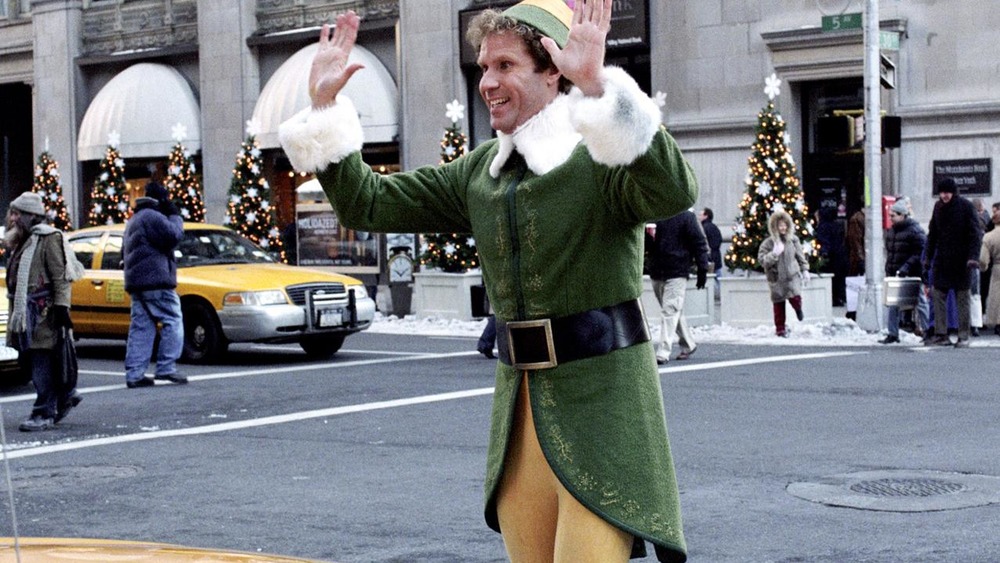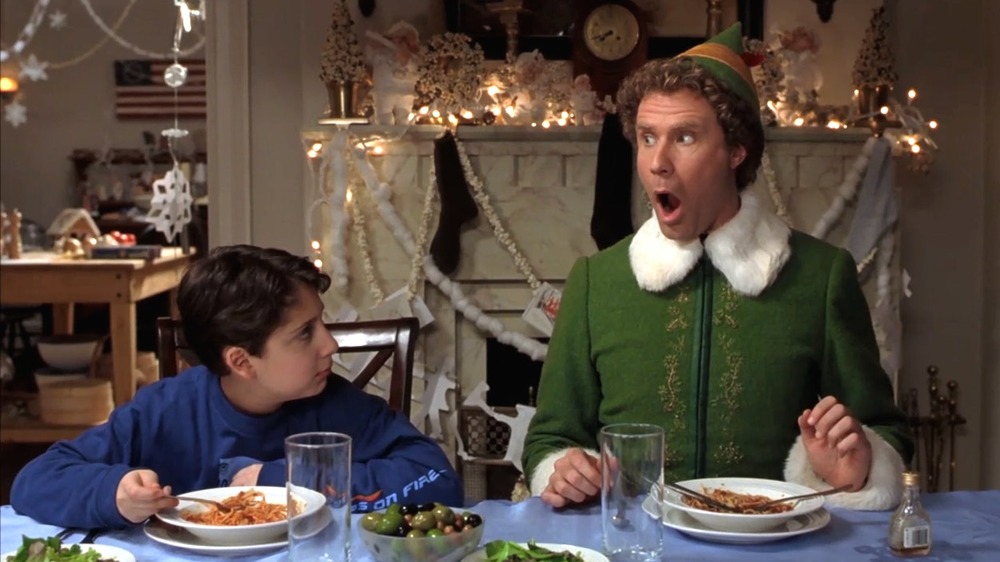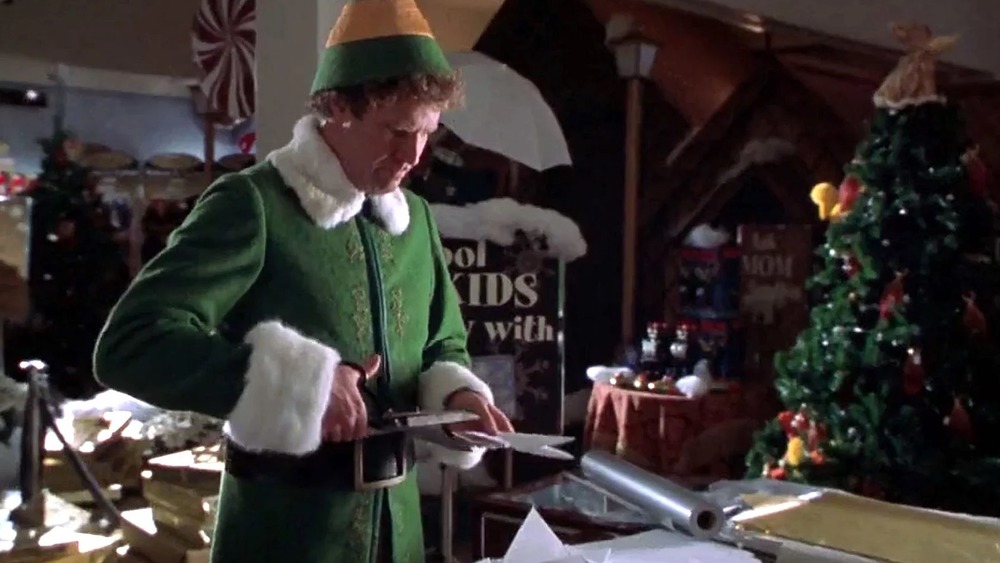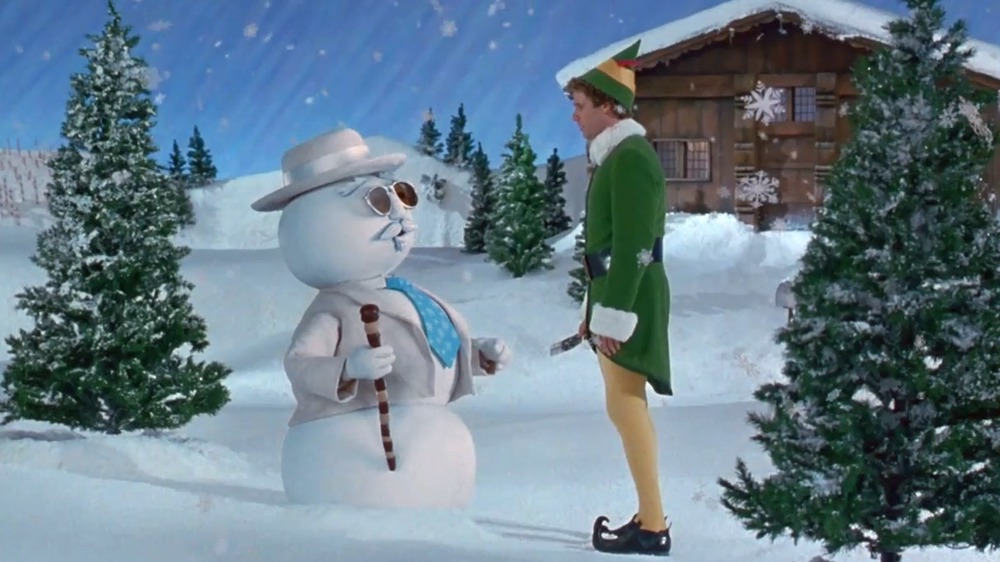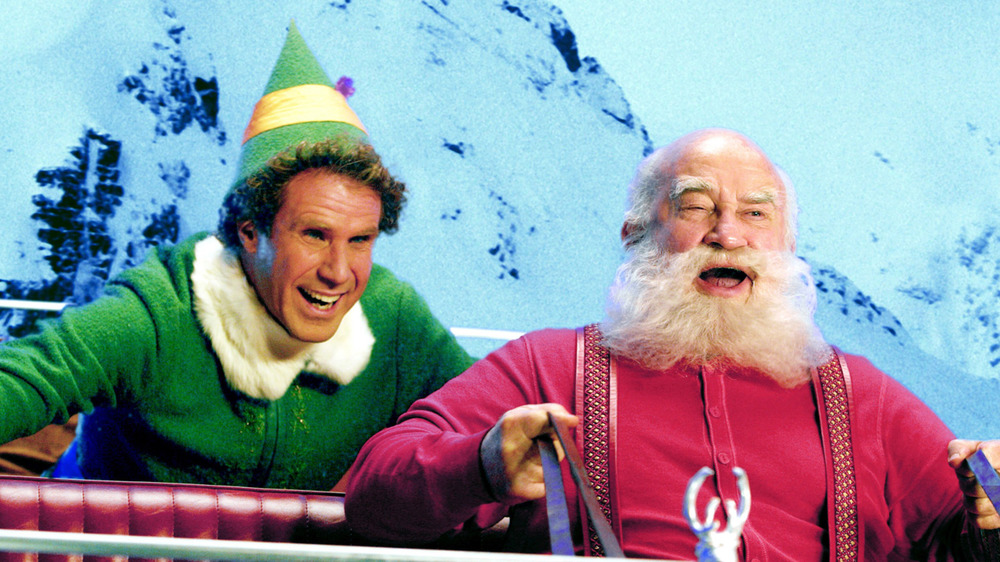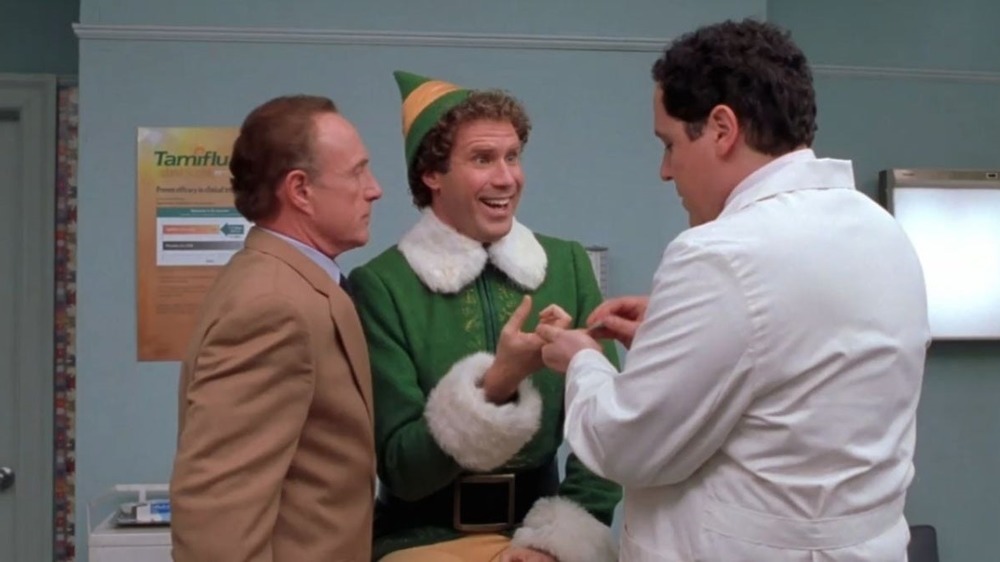The Untold Truth Of Elf
With a cast of backups, a relatively small budget, and a plot no one in Hollywood seemed to fully understand, Elf looked like it had about as much chance of succeeding as a grown human who thinks he's an elf searching for his father in New York City. But the people making the film had a clear and strong vision, inspired by the holiday specials of their childhood. Their ultimate goal was not box office glory (although that would be nice.) They wanted to make the kind of Christmas movie that families gather together to rewatch every year in the holidays.
And in that, they succeeded. This is the untold truth of Elf, including the story of building Santaland, the scene Jon Favreau added for Zooey Deschanel, the lawsuit that nearly canceled everything, what James Caan was like on set, and why there won't be a sequel no matter how much Christmas cheer we spread.
David Berenbaum wanted to make a classic Christmas movie
As a kid growing up in Philadelphia, future Elf screenwriter David Berenbaum loved Christmas — despite being Jewish. "I was raised in a Jewish family, and we celebrated Hanukkah but also had a Christmas tree. ... Hanukkah is great ... but there's kind of nothing like rushing down on Christmas morning and opening up presents," he told Philadelphia City Paper in 2013. He clarified to Jewish Journal, "It was never about Jesus, it was about Santa Claus."
Berenbaum also loved experiencing Christmas on the silver screen, and he counts It's a Wonderful Life as one of his all-time favorite films. When he moved to Los Angeles, hoping to write movies himself, that love for Christmas followed and even intensified. "It hits hardest at Christmastime when it's 105 degrees out here," Berenbaum told Variety in 2018. "It was very comforting to write a Christmas movie when you miss the snow, and there's a heatwave outside." And as it turns out, Elf was his second screenplay — the first, Christmas in New Jersey, was a Christmas rom-com.
Another theme Berenbaum wanted to explore was a son looking for an absent father. As he explained to Jewish Journal, his dad died when he was nine, so that father/son relationship — or the searching for one — is a common theme in his work. For all Elf's Christmas magic, Berenbaum's most important scene is watching Walter hug Buddy at the end.
Jon Favreau was inspired by Rankin/Bass — but not too inspired
Anyone who grew up watching Rankin/Bass specials will notice similarities with Elf, especially in the North Pole sequences. That's no coincidence. Both Berenbaum and director Jon Favreau were inspired by the studio's colorful, quirky Christmas movies. It's this spirit that gave Elf its candy cane-sweet center.
Favreau explained to Rolling Stone that the original script was much darker, and that didn't gel with him. But while trying to do a rewrite, he had an epiphany. As Favreau explained, "If I made the world that [Buddy] was from as though he grew up as an elf in ... one of those Rankin/Bass Christmas specials I grew up with, then everything fell into place tonally."
This development was great for the screenplay, but it's also the reason Elf almost never happened. As producer Cale Boyter told Netflix, "Legally, we thought we had made a deal, and everything was cool." But a good way into production, the New Line legal department panicked. Their main concern was Buddy's green costume, which looked strikingly similar to an elf uniform from Rankin/Bass and was in almost every scene.
Fortunately, the legal troubles cleared. "Thankfully, we had some pretty smart people who could figure it out," Boyter coyly put it to Netflix.
Will Ferrell was considered a risky choice for Buddy
Picturing anyone other than Will Ferrell (or an actual elf) pulling off Buddy's unbridled Christmas spirit, hopeless naivete, and yellow tights is almost impossible now. But when Elf was moving into production, he was considered a wildly improbable choice for the character.
According to Variety, Jim Carrey was the first pick, likely thanks to his roles in PG-13 movies such as Ace Ventura and The Mask. Even comedian Chris Farley was suggested before Ferrell.
At that point, Ferrell was known mainly for Saturday Night Live, which he'd just left, and for small parts in adult-only movies like the first and second Austin Powers, Jay and Silent Bob Strike Back, and Zoolander. Casting him as the lead in a family Christmas movie was a risk, but Ferrell saw doing something different as a great opportunity. He told Blackfilm in 2003, "The appeal of it was to be able to shoot a film that would be funny but also heartfelt and be a different type of thing for me to do ... something that a family audience would see."
In hindsight, it's clear that casting Ferrell was key to the movie's success. As Berenbaum told Philadelphia City Paper, "I don't think we'd be talking about the movie now if Will didn't commit to play Buddy the elf, 'cause I can't really imagine anyone else on the planet playing that role at this point."
Jon Favreau added 'Baby, It's Cold Outside' for Zooey Deschanel
Elf proved to be a big break for Zooey Deschanel, who played down-on-Christmas department store elf Jovie, whom Buddy falls in love with. But she told Variety that she was the backup choice to play the part, stepping in when the first-choice actress dropped out. This was also the case for Faizon Love, who played the stressed-out Gimbels manager. That character was supposed to be played by comedian Wanda Sykes, but Love got the part when she became unavailable. He chose to wear her "Wanda" nametag anyway.
Deschanel quickly made Jovie her own, with help from Jon Favreau. She told Entertainment Weekly that Favreau wanted to tailor the character to whoever played her. "One actress they were looking at was good at skateboarding," Deschanel said, and when the director found out Deschanel could sing, he added her now-iconic shower duet of "Baby, It's Cold Outside" with Buddy. And yes, that really is Ferrell singing. "He said he wasn't a singer," Deschanel said, adding, "I should've known he'd be secretly good!" She was also excited to record a version with Leon Redbone, of whom she was a big fan.
One Elf element Deschanel isn't a fan of is her character's blonde hair. She'd bleached her brown hair for another audition and wanted to change it back, but the Elf filmmakers decided blonde worked better.
Filming Elf came with a high sugar content
Elves thrive on the four main food groups (candy, candy canes, candy corns, and syrup, of course), but one of the dumb things we all ignored in Elf was that Buddy, as a human, would probably be very ill, if not dead, on this diet. And the cast struggled, too.
Mary Steenburgen, who played Buddy's stepmother, had to eat a bite of syrup-covered spaghetti and pretend to like it for Buddy's sake. She explained to Variety, "There are worse things in the world to eat than that, but we had been doing it for hours." Fortunately, her reflexive grimace at the too-sweet dish worked for her character. The hardest part about the mealtime scenes, Steenburgen said, was not laughing at Ferrell.
Ferrell had it worse. He not only had to eat an enormous bite of spaghetti covered in candy and syrup, he had to look like he was enjoying it with a Buddy level of enthusiasm. This challenge extended to other scenes. For example, those cotton balls the character eats in the doctor's office were made from cotton candy. Ferrell admitted to Blackfilm, "Yeah, that was tough. I ingested a lot of sugar in this movie, and I didn't get a lot of sleep." But he took it all in stride. "If it takes eating a lot of maple syrup, then I will if that's what the job calls for."
Everyone was scared of James Caan — at first
Buddy's biological father, Walter, is the workaholic, stone-faced foil to his eternally peppy personality. Originally, the filmmakers wanted comic Garry Shandling, but when he declined, they went to the next obvious choice — famous tough guy James Caan.
Initially elated when Caan took the part, the rookie producers were also a little intimidated at the thought of working with the man who played The Godfather's Sonny Corleone. "All of us were a little scared of James Caan," producer Jon Berg admitted to Netflix. But Caan soon put their fears to rest. According to Berg, on his first day on set, he gave a speech in which he asked to be called Jimmy the Dream. The production department even changed the stitching on Caan's chair to his new nickname overnight.
Although Caan lived up to his self-appointed name, he struggled to match Ferrell's relentless Christmas energy and improvising skills — which was exactly the dynamic their characters needed. "I was really lucky that my job in the film was to try to drive him crazy, and I would," Ferrell explained to Blackfilm. Favreau told Rolling Stone that Caan "always felt like he was being treated right on the set. ... But Will would bust his balls a lot. ... Eventually, something just clicked in Jimmy, and he just went with it. He was a lot of fun."
Elf's low budget forced some creative shoots
Elf made nearly seven times its $32 million budget at the box office alone, but during the shoot, money was tight. Ferrell even joked (hopefully) that they couldn't afford fake gum for that scene outside the subway station.
This meant the team relied on practical effects whenever possible. Notably, in the North Pole sequences, they used forced perspective to make Ferrell look much taller than his co-stars. As Favreau explained to Rolling Stone, they made two sets, with Favreau on the one positioned closer to the camera, and lined them up so that it looked like Ferrell was sitting right next to the people on the other set. Favreau also liked that the old-school technique made the movie feel more like one of the Christmas classics he'd loved as a kid.
They also saved money on the sequence showing Buddy exploring New York by sending Ferrell out in costume to interact with people. For example, the man in the red jogging suit he mistakes for Santa wasn't a paid actor. (But people in those scenes did have to sign releases.) "Will has really good comedic concentration so he was able to stay in character the whole time, and we used what worked," Favreau told Rotten Tomatoes. But he admitted to Rolling Stone that the sight of Ferrell in his elf costume on the side of the 59th Street Bridge did "cause a few minor traffic accidents."
Many scenes in Elf were shot in an unexpected location
Some of the movie's coziest, most Christmassy scenes were shot in a location that was neither cozy nor Christmassy — Riverview Hospital, an abandoned mental institution in British Columbia. Other productions that have shot there include The X-Files, The Twilight Zone, Halloween: Resurrection, and Black Christmas.
Production designer Rusty Smith told Netflix, "It is one of the creepiest places I've ever been in my life." But he managed to make it work for most of the interior locations you see in the movie. That includes those that lend themselves to being shot in an abandoned mental institution, such as the orphanage, the police station, the mail room, and the offices of Greenway Press. But they even managed to use Riverview for the Hobbs' chic Manhattan apartment and the Gimbels department store interior, which was in the former cafeteria.
Speaking of Gimbels, although Favreau chose the department store for its ties to another Christmas classic, Miracle on 34th Street, it had gone out of business by 2003. That meant they could buy the license to the brand, but there was no Gimbels store to shoot in. Instead, they created the window where Buddy sleeps inside the Empire State Building — with a very short turnaround time, as Smith told Entertainment Weekly. Originally, Favreau wanted to use Macy's, but the brand refused to show a Macy's Santa being unmasked (unbearded) as a fake.
The production team spent two weeks building the Gimbels Santaland
On your next Elf rewatch, take a second to pause and admire the scale Lego model of the New York skyline that Buddy builds for the Gimbels Santaland. Buddy used his elf training to construct it overnight, but it took the production team two weeks. It became an architectural project in miniature, production designer Rusty Smith explained to Entertainment Weekly. Before they could even get started, they first had to draw all the buildings and work out how many bricks they would need per building — as well as which colors — to make them look right. And then they had to source all the bricks specially.
The Lite-Brite "welcome" sign caused a similar headache since they had to source extra red and blue light pegs. Even the paper decorations were time-consuming. "People would be on the phone, they'd be sitting at the desk cutting up paper, cutting out little dolls, cutting out little curlicues to make snowflakes," Smith said.
Santaland took weeks to make but minutes to destroy. Obviously they couldn't rebuild everything again, which meant Ferrell and Artie Lange, as the Gimbels Santa, had only one take to tear the production team's hard work apart. "We shot right up until we destroy the place," Lange told ABC News. Ferrell told Blackfilm it was one of his favorite scenes to film.
The stop-motion scenes ended in a mad dash
The stop-motion North Pole scenes in Elf were Jon Favreau's idea. He told Rolling Stone that it was an essential part of the movie's retro Christmas feel, with a particular nod to Rankin/Bass. This explains why he's most proud of his cameo as Mr. Narwhal. "That's probably my most famous role of anything I've ever done because that's the one that's on T-shirts and sweaters," he told ABC.
However, Favreau had to convince the movie's studio, New Line, which was wary of spending time and money on a famously laborious technique like stop-motion. Favreau recruited the Chiodo brothers to film the sequences, whose resume included effects for the Gremlins movies and sequences in The Simpsons. They got started, but the schedule was thrown out the window when New Line arranged a preview screening before the sequences were ready. Favreau panicked that if he showed a cut of the movie without the as-yet-incomplete stop-motion scenes, the studio wouldn't let him add them in later.
So, the Chiodos ramped up their schedule. Edward Chiodo credits animator Teresa Drilling with finishing a marathon shoot on the scene with Buddy and Leon the Snowman, which was especially complicated because it involved a human interacting with a stop-motion character. "And we made the deadline, made the screening, positive reviews, the stop-motion sequences tested through the roof, really popular, so they stayed in the movie!" Edward Chiodo told Art of the Title.
The first cut of Elf lost its heart
After filming wrapped on Elf and before the movie reached preview audiences, Old School premiered. Suddenly, Ferrell was famous, specifically for playing a beer-guzzling, streaking, ribbon-dancing, ring-of-fire-jumping frat man. This newfound star status should've been good news for Elf. It turned the lead from SNL alumnus into a movie star. But it sort of backfired.
New Line executives worried that the Old School audience wouldn't want to see an earnest family Christmas movie. Rusty Smith told Netflix that after Favreau had finished his cut, the studio tried to reshape the movie into an adult comedy. In the first preview screening, the movie ended with Buddy and Santa (Edward Asner) flying away from Central Park, with no Central Park singalong or reunion between Buddy and Walter.
Fortunately, even New Line had to admit that its version didn't work, and the ending was restored. Ferrell later told Rotten Tomatoes that it was when he saw the original ending at the LA premiere that he knew the movie was special. It even made him cry.
We know now that Elf was a massive success, and it's become a welcome addition to the Christmas canon — just like Favreau and Berenbaum wanted. "I'll see pictures online of people saying, 'Hey I'm introducing my son or my daughter to this movie for the first time.' ... That really makes me happy, and it's the best part of the job," Favreau told Rotten Tomatoes.
There won't be an Elf 2, but don't blame Favreau
Despite Elf's success, there's a lump of coal to go with the Christmas joy. It's unlikely that we'll get to see an Elf 2, at least not one that stars Will Ferrell. In 2006, he turned down a $29 million offer — nearly the entire budget of the first movie — to put Buddy's tights back on.
Speaking to The Guardian about his decision the following year, Ferrell admitted that it was a lot of money but said he had no regrets. He explained that he didn't want to face criticism and accusations of money-grabbing if it didn't turn out as well as the first one, adding, "I didn't want to wander into an area that could erase all the good work I've done."
On top of that, in 2020, James Caan shed more light on why, unlike Santa's sleigh, Elf 2 never made it off the ground. "We were gonna do it. ... The director and WiIl didn't get along very well," he told sports radio show 92.3 The Fan. But to be clear, Caan wasn't talking about Favreau. In 2006, Favreau told The A.V. Club, "I know Will was attached to an Elf 2. I had never been involved with it." It's disappointing, but it makes the one and only Elf all the more special.
